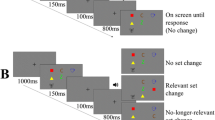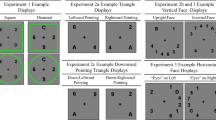Abstract
If configurations of objects are presented in a S1–S2 matching task for the identity of objects a spatial mismatch effect occurs. Changing the (irrelevant) spatial layout lengthens response times. We investigated what causes this effect. We observed a reliable mismatch effect that was not influenced by a secondary task during maintenance. Neither articulatory suppression (Experiment 1), nor unattended (Experiments 2 and 6) or attended visual material (Experiment 3) reduced the effect, and this was independent of the length of the retention interval (Experiment 6). The effect was also rather independent of the visual appearance of the local elements. It was of similar size with color patches (Experiment 4) and with completely different surface information when testing was cross modal (Experiment 5), and the nameability of the global configuration was not relevant (Experiments 6 and 7). In contrast, the figurative similarity of the configurations of S1 and S2 systematically influenced the size of the spatial mismatch effect (Experiment 7). We conclude that the spatial mismatch effect is caused by a mismatch of the global shape of the configuration stored together with the objects of S1 and not by a mismatch of templates of perceptual records maintained in a visual cache.





Similar content being viewed by others
Notes
Here and in the following we use the terms short-term memory and working memory as equivalent because in the experiments the only function of working memory is maintenance of information.
Five participants—three from the interference and two from the non-interference condition—were excluded from the analysis due to probability of recognition (PR) scores (hits minus false alarms) more than two standard deviations below their group means.
References
Andrade, J., Kemps, E., Werniers, Y., May, J., & Szmalec, A. (2002). Insensitivity of visual short-term memory to irrelevant visual information. Quarterly Journal of Experimental Psychology, 55, 753–774.
Baddeley, A. (2000). The episodic buffer: A new component of working memory? Trends in Cognitive Sciences, 4, 417–423.
Baddeley, A. D. (2002). Is working memory still working? European Psychologist, 7, 85–97.
Baddeley, A. D., & Hitch, G. (1974). Working memory. In G. H. Bower (Ed.), The psychology of learning and motivation (Vol. 8, pp. 647–667). Hillsdale, NJ: Erlbaum.
Baddeley, A. D., & Hitch, G. J. (1994). Developments in the concept of working memory. Neuropsychology, 8, 485–493.
Baddeley, A. D., & Logie, R. H. (1999). Working memory: The multiple-component model. In A. Miyake & P. Shah (Eds.), Models of working memory (pp. 28–61). Cambridge: Cambridge University Press.
Baddeley, A. D., Thomson, N., & Buchanan, M. (1975). Word length and the structure of short-term memory. Journal of Verbal Learning and Verbal Behavior, 14, 575–589.
Baylis, G. C., & Driver, J. (1993). Visual attention and objects: Evidence for hierarchical coding of location. Journal of Experimental Psychology, 19, 451–470.
Bosch, V., Mecklinger, A., & Friederici, A. D. (2001). Slow cortical potentials during retention of object, spatial and verbal information. Cognitive Brain Research, 10, 219–237.
Cowan, N. (1995). Attention and memory: An integrated framework. London: Oxford University Press.
Cowan, N. (1999). An embedded-processes model of working memory. Cambridge: Cambridge University Press.
Delis, D. C., Robertson, L. C., & Efron, R. (1986). Hemispheric specialization of memory for visual hierarchical stimuli. Neuropsychologia, 24, 205–214.
Jiang, Y., Olson, I. R., & Chun, M. M. (2000). Organization of visual short-term memory. Journal of Experimental Psychology: Learning, Memory, and Cognition, 26, 683–702.
Kanizsa, G. (1974). Contours without gradients or cognitive contours. Italian Journal of Psychology, 1, 93–112.
Kessels, R. P., Postma, A., & de Haan, E. H. F. (1999). P and M channel-specific interference in the what and where pathway. Neuroreport, 10, 3765–3767.
Kessels, R. P., Postma, A., Kapelle, L. J., & de Haan, E. H. F. (2000). Spatial memory impairment in patients after tumor resection: Evidence for a double dissociation. Journal of Neurology, Neurosurgery and Psychiatry, 69, 389–391.
Klauer, K. C., & Zhao, Z. (2004). Double dissociations in visual and spatial short-term memory. Journal of Experimental Psychology: General (in press).
Kosslyn, S. M. (1981). The medium and the message in mental imagery: A theory. Psychological Review, 88, 46–66.
Kosslyn, S. M. (1994). Image and brain. The resolution of the imagery debate. Cambridge: MIT Press.
Logie, R. H. (1986). Visuo-spatial processes in working memory. Quarterly Journal of Experimental Psychology, 38A, 229–247.
Logie, R. H. (1995). Visuo-spatial working memory. Hove: Lawrence Erlbaum.
Logie, R. H., & Marchetti, C. (1991). Visuo-spatial working memory: Visual, spatial or central executive. In R. H. Logie & M. Denis (Eds.), Mental images in human cognition (pp. 105–115). Amsterdam: North Holland.
Logie, R. H., Engelkamp, J., Dehn, D., & Rudkin, S. (2001). Actions, mental actions, and working memory. In M. Denis, R. H. Logie, C. Cornoldi, M. de Vega & J. Engelkamp (Eds.), Imagery, language and visuo-spatial thinking (pp. 161–183). Hove: Psychology Press.
Luck, S. & Vogel, E. (1997). The capacity of visual working memory for features and conjunctions. Nature, 390, 279–281.
McNamara, T. P. (1986). Mental representations of spatial relations. Cognitive Psychology, 18, 87–121.
Mecklinger, A., & Pfeifer, E. (1996). Event-related potentials reveal topographical and temporal distinct neuronal activation patterns for spatial and object working memory. Cognitive Brain Research, 4, 211–224.
Miyake, A., & Shah, P. (1999). Models of working memory. Mechanisms of active maintenance and executive control. Cambridge: Cambridge University Press.
Navon, D. (1977). Forest before trees: The precedence of global features in visual perception. Cognitive Psychology, 9, 353–383.
Palmer, S. E. (1999). Vision science: From photons to phenomenology. Cambridge, MA: Bradford Books/MIT Press.
Pazzaglia, F., & Cornoldi, C. (1999). The role of distinct components of visuo-spatial working memory in the processing of texts. Memory, 7, 19–41.
Pearson, D. G. (2001). Imagery and the visuo-spatial sketchpad. In J. Andrade (Ed.), Working memory in perspective (pp. 33–59). Hove: Psychology.
Pearson, D. G., Logie, R. H., & Gilhooly, K. J. (1999). Verbal representations and spatial manipulation during mental synthesis. The European Journal of Cognitive Psychology, 11, 295–314.
Phillips, W. A. (1983). Short-term visual memory. Philosophical Transactions of the Royal Society of London, B302, 295–309.
Postma, A., & De Haan, E. H. F. (1996). What was where? Memory for object locations. Quarterly Journal of Experimental Psychology: Human Experimental Psychology, 49A, 178–199.
Psotka, J. (1978). Perceptual processes that may create stick figures and balance. Journal of Experimental Psychology: Human Perception & Performance, 4, 101–111.
Quinn, J. G., & McConnell, J. (1996). Irrelevant pictures in visual working memory. Quarterly Journal of Experimental Psychology: Human Experimental Psychology, 49A, 200–215.
Quinn, J. G., & McConnell, J. (1999). Manipulation of interference in the passive visual store. The European Journal of Cognitive Psychology, 11, 373–389.
Robertson, L. C., Lamb, M. R., & Knight, R. T. (1988). Effects of lesions of the temporal-parietal junction on perceptual and attentional processing in humans. Journal of Neuroscience, 8, 3757–3769.
Santa, J. L. (1977). Spatial transformations of words and pictures. Journal of Experimental Psychology: Human Learning and Memory, 3, 418–427.
Tresch, M. C., Sinnamon, H. M., & Seamon, J. G. (1993). Double dissociation of spatial and object visual memory: Evidence from selective interference in intact human subjects. Neuropsychologia, 31, 211–219.
Walker, P., Hitch, G. J., & Duroe, S. (1993). The effect of visual similarity on short-term memory for spatial location: Implications for the capacity of visual short-term memory. Acta Psychologica, 83, 203–224.
Zimmer, H. D. (1998). Spatial information with pictures and words in visual short-term memory. Psychological Research, 61, 277–284.
Zimmer, H. D., & Speiser, H. R. (2002). The irrelevant picture effect in visuo-spatial working memory: Fact or fiction? Psychologische Beiträge, 44, 223–247.
Zimmer, H. D., Speiser, H. R., & Seidler, B. (2003). Spatio-temporal working-memory and short-term object-location tasks use different memory mechanisms. Acta Psychologica, 114, 41–65.
Acknowledgement
This research was supported by a grant from the Deutsche Forschungsgemeinschaft in a Special Collaborative Research Group on Resource Adaptive Cognitive Processes (SFB 378).
Author information
Authors and Affiliations
Corresponding author
Rights and permissions
About this article
Cite this article
Zimmer, H.D., Lehnert, G. The spatial mismatch effect is based on global configuration and not on perceptual records within the visual cache. Psychological Research 70, 1–12 (2006). https://doi.org/10.1007/s00426-004-0186-5
Received:
Accepted:
Published:
Issue Date:
DOI: https://doi.org/10.1007/s00426-004-0186-5




